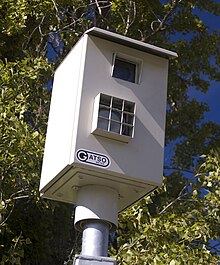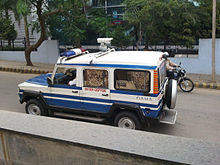车速限制执法
此条目目前正依照其他维基百科上的内容进行翻译。 (2023年8月21日) |
[[Category::en:Speed_limit_enforcement正在翻译的条目|㏴车速限制执法]]

为提高司机对车速限制的遵守程度,当局在大多数公共道路上强制执行限速。使用的方法包括由警察在路边测速(如使用雷达枪)和路边科技执法系统,这些系统可能会结合自动车牌识别系统。传统上,警察使用秒表来测量车辆行驶已知距离所需的时间。而近年,雷达枪和车载系统开始被使用。
一项包括全球的研究发现,测速相机令致命及严重伤害事故数量减少了11%至44%。英国交通部估计,测速相机使有人受伤的事故减少了22%,而在摄像头附近意外重伤或死亡的人数减少了42%[1] 。英国医学期刊最近报导称,测速相机可以有效减少附近的事故和伤害,并建议更广泛地安装。一项2017 年伦敦政治经济学院的研究提出:“在英国道路上再安装1,000 个摄像头每年可以挽救多达190条生命,减少多达1,130起碰撞事故并减少330起重伤。”[2]
历史
[编辑]限速的使用早于机动车的发明和执法。面对汽车的发明,许多国家制定了车速限制法律,并采取了合适的方法去执法。[3]英国的《机车法案》设置了针对车辆的速度限制,并于后来规定了执法方法。1861年通过的第一个机车法案将在无人居住的地区的速度限制设为10 英里每小时(16 公里每小时),而在城镇内则为5 英里每小时(8 公里每小时)以及制定了对违法行为的罚款金额。
1865年的《机车法案》出台了更严格的规定,该法案规定城镇内的速度限制为2 英里每小时(3.2 公里每小时),出城的速度限制为4 英里每小时(6.4 公里每小时)。 该法案更要求在车辆前面 60 码需有人举著红旗以作警告。1878年再修法,将车辆前方警告者的距离减少到 20 码,并且要求车辆在看到马匹时停车。[4]由于车速不能超过人的行走速度,车速限制实际上是多余的。
到1895年,一些早期的轻型蒸汽动力车司机认为这些汽车在法律上归类为无马车辆,因此车前不需要有人作警告。 汽车先驱约翰·亨利·奈特 (John Henry Knight) 以此作测试,但他后来因无照使用机车而被检控[5]。1896年的《公路机车法案》取消了1865年法案引入的一些限制,特别是将 3 吨以下的“轻型机车”的速度限制提高到 14 英里每小时(23 公里每小时)。1903年修法再次将限速提高到 20 英里每小时(32 公里每小时)。
英国一个与汽车有关的调查委员会于1907年发布报告,并对在农村地区测速以提高罚款收入而非保护城镇居民生命的做法表示担忧。 在当时的议会辩论中,有人指出“警察不是驻扎在村庄中可能有危险的地方,而是隐藏在开阔道路旁的树篱或沟渠中”,并且 “作为对公众的保护的说法显然是荒谬的,它们在许多地方仅被用作从路过的旅行者中榨取金钱的一种手段,这让人想起中世纪的强盗”。[6][7]
1905年,英国汽车协会成立以帮助驾车者避开执法。[8] 1910年,首席大法官阿尔弗斯顿勋爵 (Lord Alverston) 对一名汽车协会巡逻员和一名可能超速驾驶的司机提起了一个测试案件(贝茨诉史蒂文斯)中裁定,如果巡逻员向超速驾驶的司机发出减速信号,从而避免测速执法,该人可能犯下1885 年《预防犯罪修正案》中阻差办公的罪行。[9][10]随后,该协会开发了一个警告系统并一直使用到1960 年代,除非附近有警察测速,巡逻员会向展示协会徽章的汽车司机敬礼,但前提是他们不会因不敬礼而被起诉。[11]
Gatsometer BV公司由拉力赛车手莫里斯·加特索尼德斯(Maurice Gatsonides)于 1958 年创立,其所生产的“Gatsometer”被喻为“革命性的测速设备”。[12] 它最初是为了提高比赛成绩而开发的,但在后来被当作警察执法工具发售。Gatsometer 声称它们在1971年开发出了第一台用于道路交通的雷达,但这一说法却因雷达探测器早在1967年就已经上市销售而受到质疑。[12]而Gatsometer也在1982年生产出世界上第一台移动测速摄像头。[12][13]
在1968年2月,北卡罗来纳州、纽约州和印第安纳州开始使用了VASCAR系统,用作纪录车辆的平均速度。[14]
凯文·理查森 (Kevin Richardson) 提出了以超速罚款作为资金来源,为遵守速度限制的司机提供现金抽奖作奖励。而这个想法在2010年11月在瑞典斯德哥尔摩实践。[15]
实践方法
[编辑]
Speed limits were originally enforced by manually timing or "clocking" vehicles travelling through "speed traps" defined between two fixed landmarks along a roadway that were a known distance apart; the vehicle's average speed was then determined by dividing the distance travelled by the time taken to travel it. Setting up a speed trap that could provide legally satisfactory evidence was usually time-consuming and error-prone, as it relied on its human operators.[来源请求]
Average speed measurement
[编辑]VASCAR is a device that semi-automates the timing and average speed calculation of the original manually operated "speed trap". An observer on the ground, in a vehicle or in the air simply presses a button as a vehicle passes two landmarks that are a known distance apart, typically several hundred metres.
Automatic number plate recognition (ANPR) systems that use a form of optical character recognition read the vehicle's licence or registration plate. A computer system reads vehicle registration plates at two or more fixed points along a road, usually hundreds of meters or even kilometers apart, then uses the known distance between them to calculate a vehicle's average speed. From the mean value theorem, we know that the vehicle's speed must equal its average speed at some time between the measurements. If the average speed exceeds the speed limit, then a penalty is automatically issued.[16]
Police in some countries like France have been known to prosecute drivers for speeding, using an average speed calculated from timestamps on toll road tickets.[17]
Speed enforcement using average speed measurement is expressly prohibited in California.[18]
Instantaneous speed measurement
[编辑]

Instantaneous speed cameras measure the speed at a single point. These may either be a semi-permanent fixture or be established on a temporary basis. A variety of technologies can be used:
- Radar speed guns use a microwave signal that is directed at a vehicle; the Doppler effect is used to derive its speed.
- LIDAR speed guns utilize the time of flight of laser pulses to make a series of timestamped measurements of a vehicle's distance from the laser; the data is then used to calculate the vehicle's speed.[19]
- Sensors embedded in the roadway in pairs, for example electromagnetic induction or Piezo-electric strips a set distance apart.[20]
- Infra-red light sensors located perpendicular to the road, e.g. TIRTL.
Pacing
[编辑]Officers in some jurisdictions may also use pacing, particularly where a more convenient radar speed measuring device is not available—a police vehicle's speed is matched to that of a target vehicle, and the calibrated speedometer of the patrol car used to infer the other vehicle's speed.[21]
Cameras
[编辑]In recent years many jurisdictions began using cameras to record violators. These devices detect vehicles that are exceeding the speed limit and take photos of these vehicles' license plates. A ticket is then mailed out to the registered owner.[来源请求]
Other
[编辑]Some jurisdictions such as Australia and Ohio, allow prosecutions based on a subjective speed assessment by a police officer.[22][23] In the future there is the potential to track speed limit compliance via GPS black boxes for recidivist speeders identified in the Australian National Road Safety Strategy 2011 - 2020 section on Intelligent speed adaptation.
参考文献
[编辑]- ^ Wilson, C; Willis, Hendrikz. Speed cameras for the prevention of road traffic injuries and deaths (PDF). The Cochrane Database of Systematic Reviews (10). 2010. PMID 20927736. doi:10.1002/14651858.CD004607.pub3.
- ^ Science, London School of Economics and Political. Speed cameras reduce road accidents and traffic deaths, according to new study. London School of Economics and Political Science.
- ^ Willett, T. C. Criminal on the road : a study of serious motoring offences and those who commit them. Abingdon, Oxon https://www.worldcat.org/oclc/900481366. 2001. ISBN 978-1-315-01350-3. OCLC 900481366. 缺少或
|title=为空 (帮助) - ^ MVRUS - Legislation | DoE Road Safety. UK Department of the Environment. 2009-09-03. (原始内容存档于2009-09-03) (英语).
- ^ History of Farnham. [26 April 2010]. (原始内容存档于2010-01-18).
- ^ Debate on the Royal Commission on Motor Cars. Hansard. 24 May 1906 [17 April 2010]. (原始内容存档于2009-07-01).
- ^ MOTOR CAR LEGISLATION. Hansard. 16 July 1907 [17 April 2010]. (原始内容存档于2009-07-01).
I regard the abolition of the speed limit as the most important recommendation of the Royal Commission... Policemen are not stationed in the villages where there are people about who might be in danger, but are hidden in hedges or ditches by the side of the most open roads in the country... I am entirely in sympathy with what the noble Earl said with regard to police traps. In my opinion they are manifestly absurd as a protection to the public, and they are used in many counties merely as a means of extracting money from the passing traveller in a way which reminds one of the highwaymen of the Middle Ages.
- ^ About us. The AA. [26 February 2010]. (原始内容存档于2010-03-01).
- ^ JA Coutts, 'Obstructing the Police' (页面存档备份,存于互联网档案馆) (1956) 19 MLR 411
- ^ Road Traffic – 1900– 1929. swarb.co.uk. [27 February 2010]. (原始内容存档于2010-04-23).
- ^ The Daily Telegraph. [2023-01-26]. (原始内容存档于2010-02-06).
- ^ 12.0 12.1 12.2 History. Gatsometer. [18 April 2010]. (原始内容存档于10 March 2010).
- ^ Radar Speed Trap Warning Apparatus (Licence). Hansard. 2 March 1967 [25 April 2010]. (原始内容存档于2011-01-19).
a pocket-sized instrument is being produced by Marchant House Limited of New Street, Oadby, Liecester, to be used in motor vehicles to give instant warning of a police radar speed trap ... Anyone wishing to use this type of apparatus would require a licence under the Wireless Telegraphy Act, 1949. The firm in question has recently been informed that I am not prepared to issue a licence for such purposes
- ^ The Highway: Versatile VASCAR. Time. 9 February 1968. (原始内容存档于29 October 2010).
- ^ Schultz, Jonathan. Speed Camera Lottery Wins VW Fun Theory Contest. The New York Times. 30 November 2010 [2023-01-26]. (原始内容存档于2022-03-08).
- ^ Specs spies on speeding motorists. BBC News. 14 July 2005 [31 May 2008]. (原始内容存档于2007-03-19).
- ^ Brian Bell. Insight Guide: French Riviera. Langenscheidt Publishers. 2001: 318. ISBN 978-1-58573-148-0.
- ^ CVC 40802 Speed Traps (页面存档备份,存于互联网档案馆), CVC 40801 Speed Trap Prohibition (页面存档备份,存于互联网档案馆)
- ^ US 5521696,Dunne, Jeremy G.,“Laser-based speed measuring device”,发表于1996-05-28,指定于Laser Technology Inc.
- ^ Police Speed Enforcement Cameras. Safer motoring. [19 April 2010]. (原始内容存档于2021-04-20).
- ^ Police Technology 2004. Pearson Prentice Hall. 2004: 15. ISBN 978-0-13-114957-1.
- ^ Police officer's visual estimate of speed is enough for a conviction, Ohio Supreme Court rules. 2 June 2010 [2023-08-20]. (原始内容存档于2018-06-25).
- ^ Alan Buckingham. Speed Traps: Saving Lives or Raising Revenue?. 17 October 2003 [27 April 2010]. (原始内容存档于2022-03-02).
